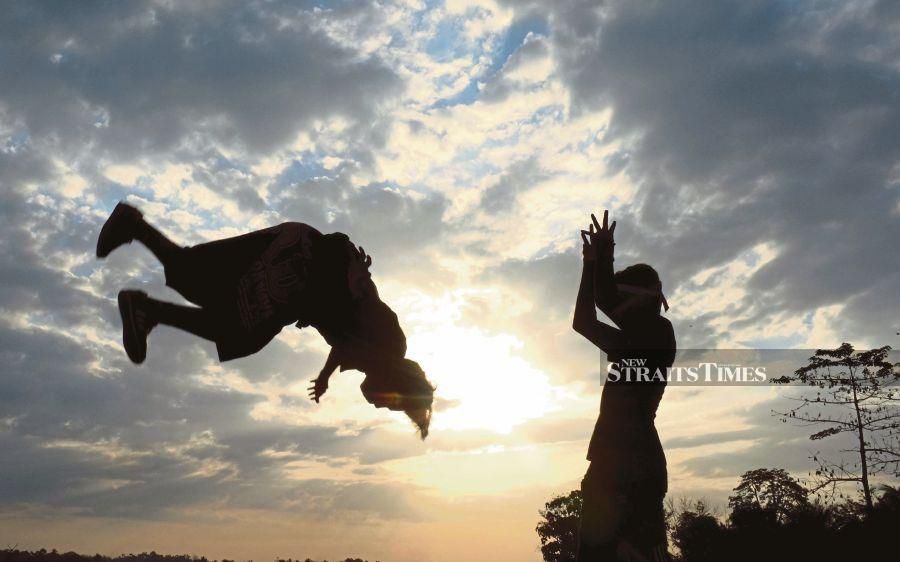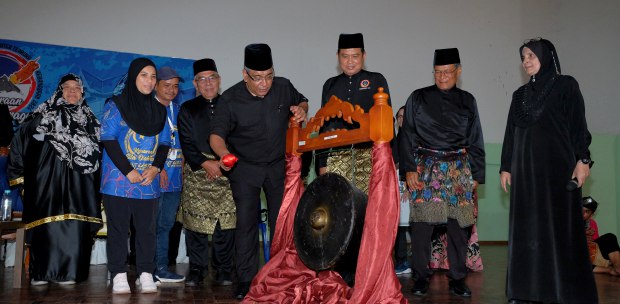In pre-colonial times, silat was the "clothing" of men and women who were willing to endure the training.
They were trained at a young age in the gelanggang, or training area, either a roofless space bounded by bamboo and palm leaves, or a roofed facility.
Practitioners trained for about three to four months, to master the basics of silat, which include the bunga, or "flower", and the buah or "fruit".
Bunga is a set of steps, gestures, and positions that allow the practitioner's body to hidup, or "come alive".
Bunga trains the reflexes so that offensive and defensive action can be spontaneous and effective.
Buah, on the other hand, teaches techniques of evading, blocking, parrying, striking, locking, grappling and some acrobatics useful in fights.
Bunga and buah are practised with bare hands or weapons.
The more accomplished practitioners were recruited by the palace to serve as warriors for the king or sultan, called hulubalang for men and srikandi for women.
Serving the sultan also allowed the warrior to train and test his or her skills with others and mercenaries from other ethnic backgrounds.
The hulubalang protects the sultan at the palace as well as on trips and in battles.
The srikandi protects the sultan's family. Their most notorious weapon is the kerambit — a small curved blade that can be concealed as a hairpin.
Other than normal palace routines, the hulubalang and srikandi were also performers during royal events, such as the sultan's birthday, coronation and for welcoming foreign dignitaries.
Their performances ranged from meta-physical prowess, such as eating glass and withstanding deadly blows from weapons, to choreographed fights, and performances of bunga and court dances.
These performances, as well as the warriors themselves, slowly faded as European invaders sought to curb potential uprisings.
Warriors had to relinquish their status in the palace and return to their towns and villages.
The colonial period brought changes to the practice and training of silat.
Training was done in remote locations, such as on the outskirts of villages or in jungles, and only at night.
These conditions made it hard for silat to maintain its role as "clothing", or knowledge and skills that everybody could and should learn.
Malay weddings have become new arenas of silat performance.
The bride and groom are called raja sehari, or "king and queen of the day", and the bunga of silat became the most prominent performance at these occasions.
After Malaya achieved independence from the British in 1957, the popularity of martial arts from Japan and China among Malay youths was a major concern for some silat masters.
Thus, silat organisations came into existence not just in villages, but all over the country.
These new silat organisations started a revolution in terms of performance. They opted to leave out the bunga and focused more on the buah and the choreographed fights, or tempur.
These fights were done in public areas to entice audiences. These strategies were successful in attracting Malay youths as well as the government.
The latter felt that silat was a method to unite Malays once separated by different kingdoms and sub-ethnicities (such as the Minang, Javanese, Bugis and Kedahans), and give them a sense of unified identity.
This unity became most apparent during the 1969 racial riots in Kuala Lumpur. The riots became the stage for silat groups to apply what they had been training.
After peace was achieved, some silat masters reflected upon the role of silat. They saw that silat had become too aggressive and the practitioners themselves became less approachable due to their belligerent nature.
The masters acknowledged that relegating or abandoning the practice of bunga had made silat too unstable as an art.
Therefore, a new revolution took place where even silat organisations that were previously adamant in their focus on buah and tempur, started to make bunga a mandatory curriculum.
The writer is a senior lecturer at the School of Tourism, Hospitality and Event Management in the College of Law, Government and International Studies, Universiti Utara Malaysia
The views expressed in this article are the author's own and do not necessarily reflect those of the New Straits Times





